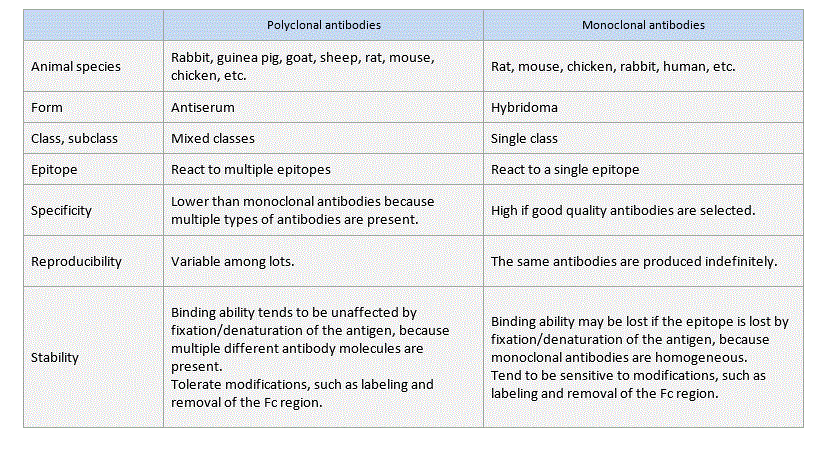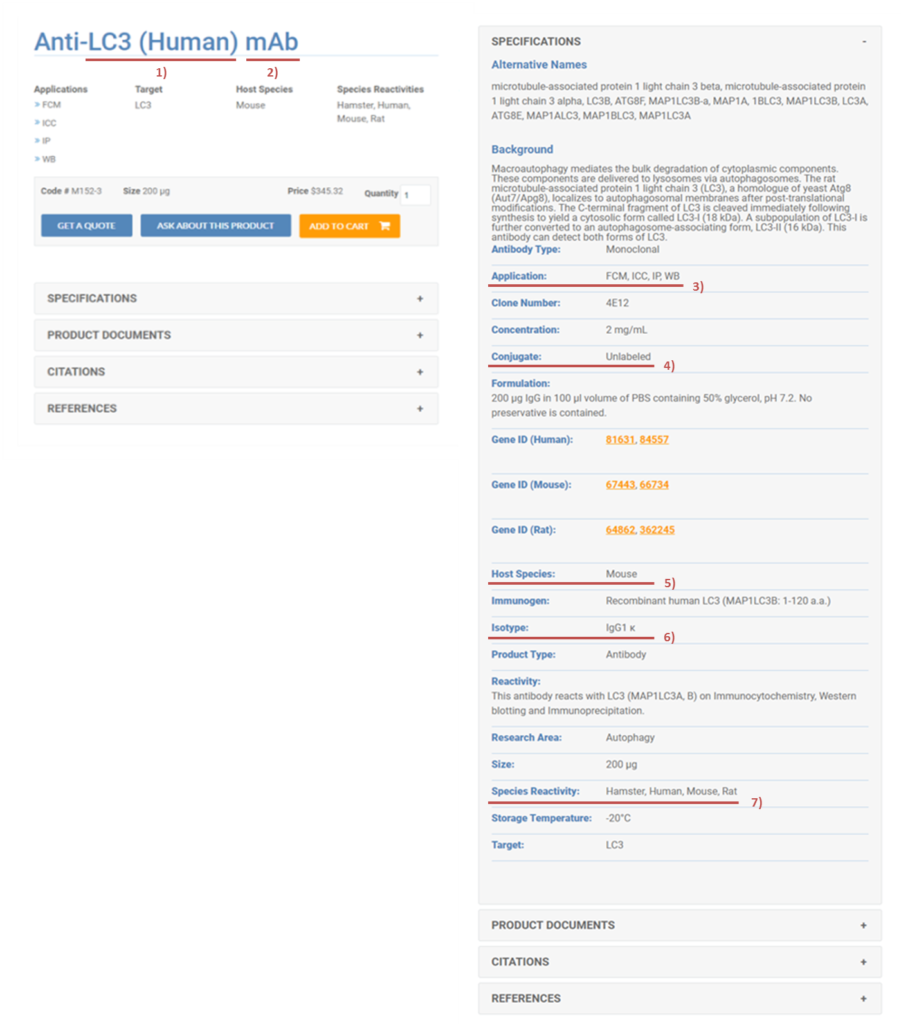How to select antibodies
Antibodies as a research tool
Researchers have taken advantage of the high specificity of antibodies for antigens to gain access to various information.
1) Detection of target molecules
- Antibodies are used to determine the expression levels and localization of molecules of interest.
- Application: Western blotting, immunoprecipitation, ELISA, flow cytometry, immunohistochemistry, etc.
2) Isolation and purification of target molecules
- Only the target molecules are isolated from complex mixtures, such as cell and tissue extracts, containing numerous proteins, nucleic acids, amino acids, hormones, etc.
- Example: Epitope-tagged proteins are purified with antibody-coated agarose
3) Isolation and purification of cells
- Cells expressing a cell surface target protein are isolated from a mixture of cells using antibody to the target protein.
4) Functional analysis of target molecule in vivo
- Functions of target molecules are analyzed in vivo by administering inhibitory (or stimulatory) antibodies to cultured cells and experimental animals.
- Example: Anti-tumor effect of the antibody to the Treg marker GITR (DTA-1) was evaluated in tumor-bearing mice.
Difference between polyclonal and monoclonal antibodies

Issues to consider when selecting antibodies
Check the following information to select appropriate antibodies for your experimental plan. Required information is in product name and “Specifications” in our product page.

1) Name of the antigen
xx in Anti-xx is the name of the antigen. Search with the term “Anti-xx (name of the molecule of interest)” first. Also search with alternative names and abbreviations.
2) Clonality
mAb: Monoclonal antibody
pAb: Polyclonal antibody
3) Application
It is important to know whether the antibody is suitable for the planned application. The antibody in this example was suitable for Flow cytometry, Immunocytochemistry, Immunoprecipitation and Western blotting.
4) Conjugate
For a secondary antibody, select a label suitable for the planned experimental system (fluorescent dye, enzyme, magnetic beads, etc.).
- Information about labeling antibodies
5) Host Species
Information about the immunized animal is important when selecting a secondary antibody.
- Information about secondary antibodies
- Information about immunized animals
6) Isotype
Information about the isotype is important when selecting a secondary antibody and an isotype control. An “isotype control” is a negative control in an experiment. An antibody that does not recognize the target molecule of the same isotype is used as an isotype control. In the example above, the information about the subclass and the type of L chain is also shown (IgG subclass: IgG1 type of L chain: κ chain).
- Information about secondary antibodies
- Information about isotypes
7) Species Reactivity
When an antibody reacts to an antigen from a particular species, the antibody is said to “cross-react” with the antigen from that species. Check for cross-reactivity with the antigen from the animal species used in your experiments. Also check whether the antibody reacts with antigens from only a single species such as mice or humans, or with antigens from multiple species, such as mice, humans, and rats. In the above example, the antibody cross-reacted with the same antigen from humans, mice, rats, and hamsters.
Important issues to consider when selecting polyclonal antibodies
Method of purification
IgG (IgM): IgG (IgM) was fractionated from serum.
IgG2a, etc.: IgG subclasses were separated and purified.
Affinity Purified Ig: Affinity-purified with immobilized antigen
Highly purified antibodies are less likely to cause non-specific reactions.
Important issues to consider when selecting monoclonal antibodies
Clone
Monoclonal antibodies to the same antigen, but produced by different clones, recognize different epitopes of the antigen. Also, different clones are recommended for different applications.
Method of purification
Check whether the antibody has been purified. Some products are culture supernatants without purification. Highly purified antibodies are less likely to cause non-specific reactions.
- Information about purification of antibodies
Secondary antibodies
What are secondary antibodies?
Secondary antibodies are used to detect primary antibodies. A primary antibody, generated in one animal species, is detected with a secondary antibody generated in another animal species. Secondary antibodies are usually labeled.
Example of selection:
- Primary antibody: Anti-mouse LC3 antibody (generated in rabbits)
- Secondary antibody: Anti-rabbit IgG antibody (generated in goats)
Issues to consider when selecting secondary antibodies
Immunized animals
Check the animal species in which the primary antibody to the target molecule is generated.
Label
Select a label suitable for the planned experimental system (fluorescent dye, enzyme, etc.).
Related Links
*Antibody
→Antibody basics
→Antibodies as a research tool
- How to select antibodies
- Labeled antibodies
- How to label antibodies
- Main causes of non-specific reactions
- How to reduce non-specific reactions
- Tags and Tag antibodies
*Qualitative and quantitative measurements of proteins using antibodies
- Western blotting (WB)
- Enzyme-linked Immunosorbent assay (ELISA)
- Immunoprecipitation (IP)
- Co-immunoprecipitation (Co-IP)